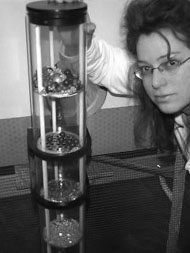
![]()
|
|
|
1. Cut your tennis-ball can into 4 equal sections with a knife. 2. Take the bottom section of the container and wrap duct tape all the way around the rim, extending 1 inch above the rim. 3. Cut slits in the tape from the top down to the rim of the container at intervals of an inch. 4. Peel back the tape like peeling a banana. 5. Prepare your smallest screen-the 1/4" mesh-into a 4" x 4" square by either cutting it with the wire cutters, or by bending a 4" section back and forth until it breaks off. 6. Center the screen over the bottom container section and roll the 1" sections of tape onto the screen to secure it. 7. Wrap tape around the top and bottom of one of the middle sections of the container with the tape extending an inch beyond the top and bottom. 8. Cut slits into the tape around the bottom of the section every inch and peel it back. 9. Place this section of the container on top of the bottom section and tape it to the screen. 10. Following the same procedure, attach the next two sections of the can, placing the 1/2" mesh between the second and third sections and the chicken wire between the third and fourth sections. 11. Wrap duct tape around the edge of each screen so there are no sharp edges. 12. Fill your container with a mixture of all four kinds of round objects. Use only a few of the largest objects and progressively more of each smaller size. Put the cap on the container. |
|
Hold the container upright and shake it. The round objects will fall through the screens until they hit a screen that they are too big to fall through. You should end up with the objects all sorted out on each of the four levels! Turn the container upside down and shake it, and all of the objects will end up in the top section of the container.
You can uncap the container, remove the objects, and add
different ones. Try to find other sets of objects that are
the right sizes to be sorted by the giant sieve.
|
|
This is a sieve that sorts objects by size. Its screens act as boundaries, allowing objects that are small enough to pass through and preventing the passage of objects that are too large. There are many natural boundaries that sort objects by size. A familiar example is a small animal hiding in a hole small enough to act as a boundary to its larger predator. An example within our own bodies is that our cell membranes allow the small glucose molecule to enter and exit, while the larger starch molecule must be broken down into glucose before it can enter the cell. No boundaries are perfect. All allow some things to leak through. Boundaries that determine passage based on size are common. |
